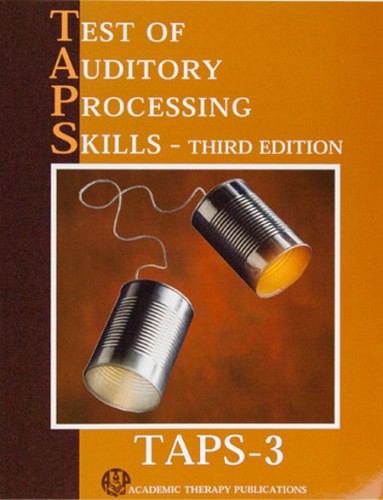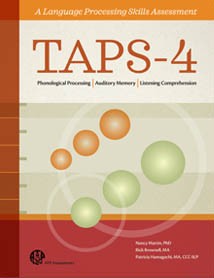Test of Auditory Processing Skills (TAPS-3)
Complete Kit
- Ages 4-0 through 18-11 years
- Testing Time 1 hour
- Administration Individual
-
Product Code 8338-2 ( MR #035126 )
* Qualifications required to purchase this item. Click here to complete the qualifications form.
*DISCONTINUED (*NEW EDITION in Alternatives below)
The Test of Auditory Processing Skills (TAPS–3) measures what a person does with what is heard.
It represents a very thorough reshaping of the Test of Auditory Perceptual Skills, Revised (previously authored by M. Gardner). The most obvious change is that there are no longer two “levels” of the test — the TAPS-3 offers seamless coverage for ages 4 through 18 years. It is designed to be used by speech-language pathologists, audiologists, school psychologists, and other testing professionals.
Subtests
• Word Discrimination
• Phonological Segmentation
• Phonological Blending
• Numbers Forward
• Numbers Reversed
• Word Memory
• Sentence Memory
• Auditory Comprehension
• Auditory Reasoning
The order of subtests now reflects a developmental progression of tasks from easiest to most difficult. Four New subtests have been added:
Phonological Segmentation, Phonological Blending, Auditory Comprehension, and Auditory Reasoning (this replaces the Auditory Processing subtest from previous editions).
New items were developed for many subtests, such as Auditory Reasoning, which now contains all new items specifically designed to tap auditory cohesion, a higher-order process. An optional Auditory Figure-Ground task on CD flags attention problems and gives feedback about auditory processing in “real-world” situations. The introductory chapter of this manual presents an updated literature review.
There are also notable differences in how scores are derived and the types of scores obtained. The use of partial credit in some subtests reflects more accurately the child’s auditory abilities. In addition to one overall score, individual subtest scores are combined to derive three cluster scores:
» Phonological Skills (Word Discrimination, Phonological Segmentation, and Phonological Blending subtests)
» Auditory Memory (Number Memory Forward, Number Memory Reversed, Word Memory, and Sentence Memory)
» Auditory Cohesion (Auditory Comprehension and Auditory Reasoning subtests)
Administration and Scoring The TAPS–3 remains an untimed test. Detailed scoring criteria are provided. The TAPS–3 norms are now nationally stratified, based on data from more than 2,000 students. Individual subtests are reported as scaled scores, while cluster scores (Phonological Skills, Memory, and Cohesion) and the overall score are reported as standard scores; percentile ranks and age equivalents are also provided.

 Proud to be Canadian
Proud to be Canadian
